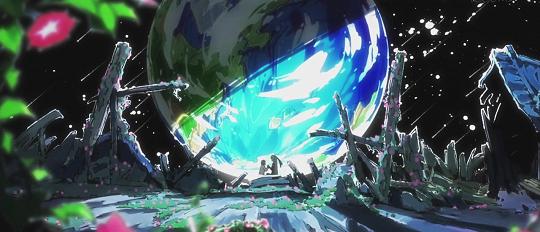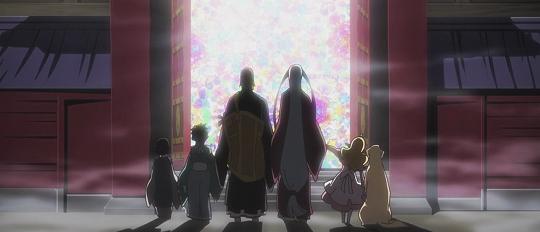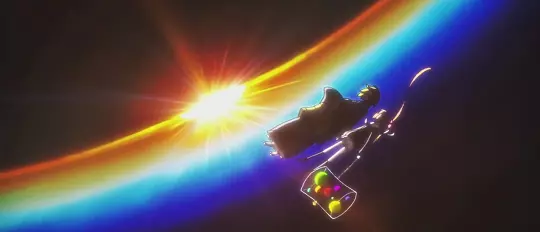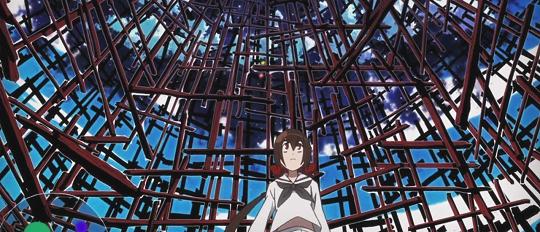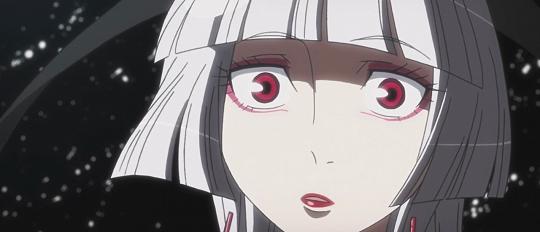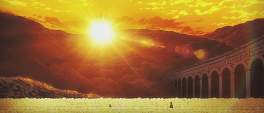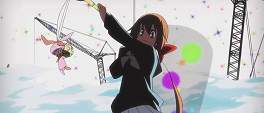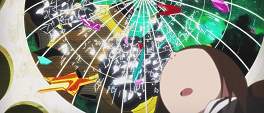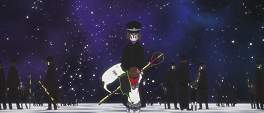When you adore something, it’s hard not to slip into superlatives when describing it. So strong is that swell of emotion that it almost feels like words aren’t enough to encompass just how much something personally means to you. I adore Kyousougiga. It’s beautiful and flawed and moving and stunning in ways that little else is. It’s telling that those who talk about the series gush like crumbling dams, desperately trying to hold back a torrent of enthusiasm.
The obvious question though is what Kyousogiga (Capital Craze) is about? It would be disingenuous to the series to just enumerate its many themes and storylines, and the simplest answer is reiterated at the beginning of each episode: it’s a story about love and rebirth in a family across time and dimensions. It’s a grand claim not entirely borne out by the first episode - confusingly numbered 00 - which is a maelstrom of technicolour bedlam set to the sounds of children laughing and adult scorn.
But as the story unfurls, dashing back and forth through time and characters, it becomes increasingly apparent that this isn’t any ordinary story. It starts with a man whose drawings come to life - Mushishi fans rejoice - and finishes with nothing less than the destruction and recreation of the universe and all its dimensions. At the heart of this, but by no means the protagonist, is Koto. A teenage girl with an infectious smile, more energy than should be allowed and a pragmatic attitude that lays bare any obstacle in her path; like an unstoppable force of nature she is without doubt the vehicle for the plot’s progression but far from its only star.
Beyond the first few scene setting episodes is a trio of storylines that teases out the quddities of the other cast members: an ogre, a bookish child old before his time and a runaway boy. Though the plot dances between timelines and motives, nothing is ever hidden unnecessarily and is never dwelled upon longer than it has to be. This means from the outset, the minutiae of the story is laid bare, only that doesn’t become apparent until the final heartwarming scene; much like the opening animation that blatantly reveals far more than can be known on first viewing.
Short of the exposition motherlode in the penultimate episode, everything zips along at a breathtaking pace and like the many dimensions of the story, so too are layers hidden behind layers of meanings. Nothing is taboo here and the frightening and unyielding way suicide is handled is juxtaposed against a molten copper sunset and golden wheat fields. No judgement is passed and there is a pleasing lack of delineation between good and evil, right and wrong, that is perfectly in line with the focus on gods and deities. Not to say that it is religious, only spiritual with life and creation treated without bias.
Of course this doesn’t stop the series coursing with Japanese influence, the story itself was inspired by (or at least named after) the ancient Chouju-jinbutsu-giga scrolls that depict frolicking humanoid animals. Like the fluid lines of those images, Kyousougiga itselfs is depicted in multicoloured glory with a sketched, almost scribbled art style that is perfectly suited to both quiet reflection on a snowy mountain to the constant motion of, well, just about everything. So just as Koto smashes and careens through the anachronistic Japanese city, Lady Koto is lithe, graceful and exquisitely alluring in a way that should make CLAMP jealous. More than just motion though are the faces that capture every surprise, every smile and every aching tear that makes it all but impossible not to grin or cry with the characters.
Like the opening states then, Kyousougiga is about family and the transcendental power it has, even when your family life isn’t straightforward and your family members aren’t even all human. By contrast though it is also about absent parents, self-loathing gods and finding meaning in a life twice abandoned. It’s about all of these things and so much more but proves that you don’t have to paint a work of art to be beautiful; you don’t have to have pin-sharp animation to be graceful; and you don’t have to be straightforward to be understandable. There is so much to love in the series that’s difficult not to just call it gobsmacking and be done with it, suffice it to say then that I simply adore it.
